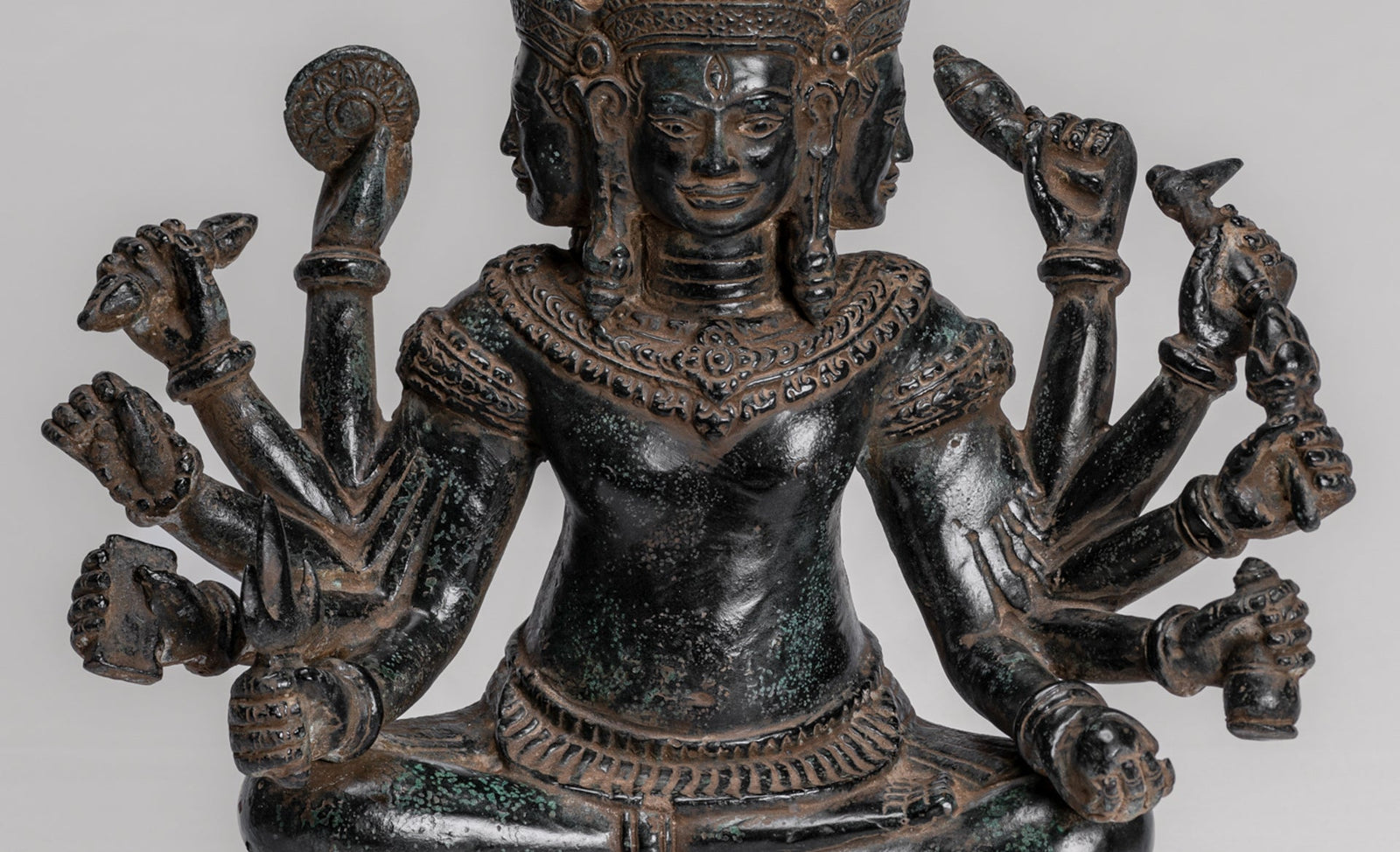
Le Trimurti dans l'hindouisme: la trinité divine de la création, de la préservation et de la destruction
Dans le monde vaste et richement symbolique de l'hindouisme, peu de concepts sont aussi centraux - et aussi puissants artistiquement - comme le Trimurti, la trinité divine qui personnifie les fonctions cosmiques de création, préservation, et destruction.
Ce trio se compose de Brahma le créateur, Vishnu le conservateur, et Shiva le destructeur. Ensemble, ils forment une vision unifiée du cycle de l'existence - où les débuts, le maintien et les fins ne sont pas des forces d'opposition, mais des phases interconnectées d'un seul processus divin.
Origines et fondements philosophiques
L'idée du Trimurti émerge des textes hindous classiques et des systèmes philosophiques, en particulier le Puranas et Vedanta, qui a cherché à consolider les divers brins des divinités védiques en un cadre plus structuré et métaphysique. Bien qu'il ne soit pas un concept directement souligné dans les premiers hymnes védiques, le Trimurti a été systématisé plus tard pour refléter l'équilibre des énergies universelles.
Le Trimurti représente Trois aspects essentiels de Brahman, la réalité ultime et sans forme dans Advaita Vedanta. Chaque divinité reflète une fonction cosmique:
-
Brahma: Le dieu de la création, responsable de la manifestation de l'univers et de toutes les formes en son sein.
-
Vishnu: Le soutien et le protecteur du Cosmos, qui descend dans divers avatars (comme Rama et Krishna) pour restaurer le Dharma (ordre cosmique).
-
Shiva: Le destructeur ou le transformateur, qui termine des cycles pour que la création puisse recommencer.
De cette façon, le Trimurti symbolise le cycle samsarique—Birthe, vie, mort et renaissance - central à la cosmologie hindoue.
Les trois divinités du Trimurti
Brahma: le créateur
Brahma est traditionnellement représenté avec quatre visages, symbolisant les quatre Vedas, quatre Yugas (âges) et quatre directions. Assis sur un lotus, il tient des objets sacrés comme un Kamandalu (pot à eau), un livre, un chapeletet un fleur de lotus, dénotant sa sagesse créative.
Malgré son rôle central, Brahma est rarement adoré aujourd'hui, et les temples dédiés à lui sont extrêmement rares, le plus célèbre étant le Temple Brahma à Pushkar, Rajasthan. Son rôle diminué dans la dévotion populaire est souvent expliqué à travers les mythes, y compris celui où il est maudit pour la fierté ou la tromperie.
Vishnu: le conservateur
Vishnu est peut-être la divinité la plus adorée parmi les Trimurti, en particulier dans le Tradition Vaishnava. Il est représenté avec un visage serein, un teint bleu et quatre bras tenant le conch (shankha), disque (chakra), Mace (Gada), et Lotus (Padma)- Chacun symbolisant divers aspects de la puissance et de la protection divines.
La grandeur de Vishnu réside dans son avatars—Notamment Rama, Krishna, et le futur Kalki- qui apparaissent en période de déséquilibre cosmique pour maintenir la justice. À travers ses incarnations divines, Vishnu reste éternellement présent dans le monde, assurant sa protection et sa boussole morale.
Shiva: le destroyer et le transformateur
Shiva est une divinité complexe et multiforme - ascétique et chef de ménage, danseuse cosmique et yogi méditatif, destructeur féroce et seigneur compatissant. Son rôle dans le Trimurti est pas purement destructeur Dans un sens négatif, mais plutôt transformateur: il dissout les illusions et les anciennes formes pour préparer la voie aux nouveaux débuts.
Iconographiquement, Shiva est montrée avec Un troisième œil, Un croissant de lune, cheveux emmêlés à partir de laquelle coule le Gange sacré, et le Trishula (Trident). Il est parfois représenté dans le Nataraja forme - performante le Dance cosmique (tandava)Au milieu d'un cercle de feu, piétinant l'ignorance sous ses pieds.
Symbolisme de l'unité et de la diversité
Le Trimurti illustre un profond unité en divers. Bien que chaque Dieu ait un rôle distinct, ils ne sont pas des divinités concurrentes mais Expressions harmonieuses d'une réalité cosmique. Cette conception triadique est parallèle à de nombreuses trinités culturelles et philosophiques à travers le monde: création - entretien-destruction, passée-présent - infumée, corps - mind-spirit.
Dans certains arts et sculptures hindoues, le trimurti est montré comme un single à trois têtes, fusionnant les trois formulaires. Un exemple étonnant est le Sculpture de Trimurti dans les grottes d'Elephanta près de Mumbai, où trois visages majestueux sont sculptés à partir de la pierre, chacun représentant une divinité en continuité sereine.
The Trimurti et Devi: un Web cosmique plus large
Bien que le Trimurti soit central, l'hindouisme met également l'accent sur le rôle du Féminine divine (Devi), sans qui les pouvoirs de Trimurti restent en sommeil. Chaque Dieu est jumelé à une déesse:
-
Saraswati (Connaissance) est le consort de Brahma.
-
Lakshmi (la richesse et le bien-être) est Vishnu.
-
Parvati (Power and Transformation) est celle de Shiva.
Ces paires divines Balance Shakti (énergie féminine) et Purusha (Esprit cosmique), renforçant l'interconnexion et la co-dépendance de toute existence.
Trimurti dans l'architecture et l'art du temple
Dans l'iconographie du temple hindou, le Trimurti apparaît souvent sur les lintels, les niches centrales ou comme des sanctuaires séparés. Les temples du sud de l'Inde, en particulier à partir des périodes Chola et Pallava, ont développé de superbes représentations de bronze et de pierre des trois dieux. Dans la sculpture, l'utilisation de la posture (mudra), des attributs (Ayudhas) et du symbolisme varie selon la région et la secte, mais renforce toujours leurs rôles cosmiques unifiés.
Les temples dédiés aux trois divinités sont rares, mais certaines traditions - comme les Tradition Smarta Fondée par Adi Shankaracharya - Imphastez équanimité vers les trois.
Héritage et pertinence
Le Trimurti reste un symbole puissant dans la pensée hindoue et l'expression artistique. Au-delà de la mythologie et du rituel, il offre un lentille spirituelle à travers lequel les modèles de vie changeants peuvent être compris - pas comme le chaos, mais dans le cadre d'un rythme divin.
Dans les temps modernes, le Trimurti sert également de métaphore pour équilibre dans la vie humaine- La nécessité de créer, de maintenir et de lâcher prise. Cela nous rappelle que La transformation n'est pas la destruction pour elle-même, mais le motif de renouvellement.
Conclusion
Le Trimurti incarne une vision cosmique de l'équilibre et de l'intégrité. Il rassemble des énergies disparates - l'acte, l'existence et la dissolution - dans un seul cycle dynamique.
En tant qu'idée spirituelle, artistique et philosophique, le Trimurti reste profondément ancré dans l'imagination hindoue, façonnant comment la vie est perçue, honorée et vécue.
Que ce soit dans les temples en pierre, les textes classiques ou les chants de dévotion, le Trimurti continue d'inspirer un sentiment d'harmonie au milieu du flux de l'existence - une triade sacrée dansant au cœur du Cosmos.


